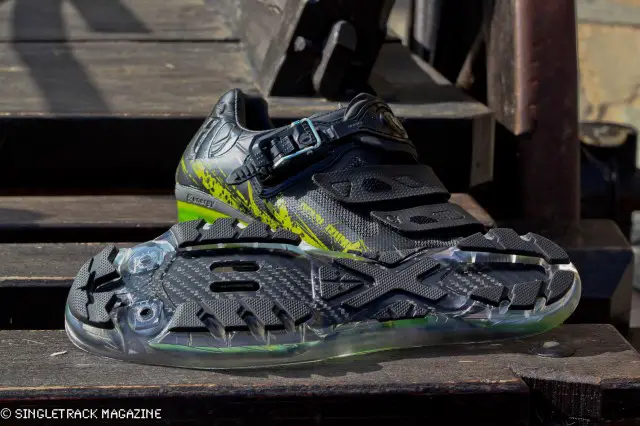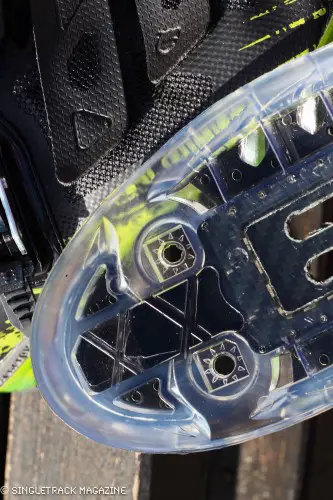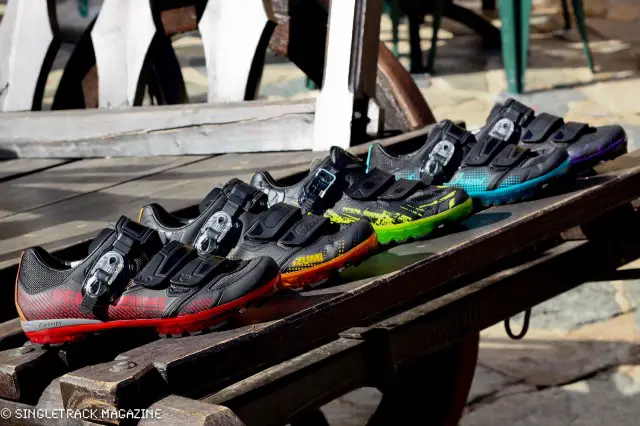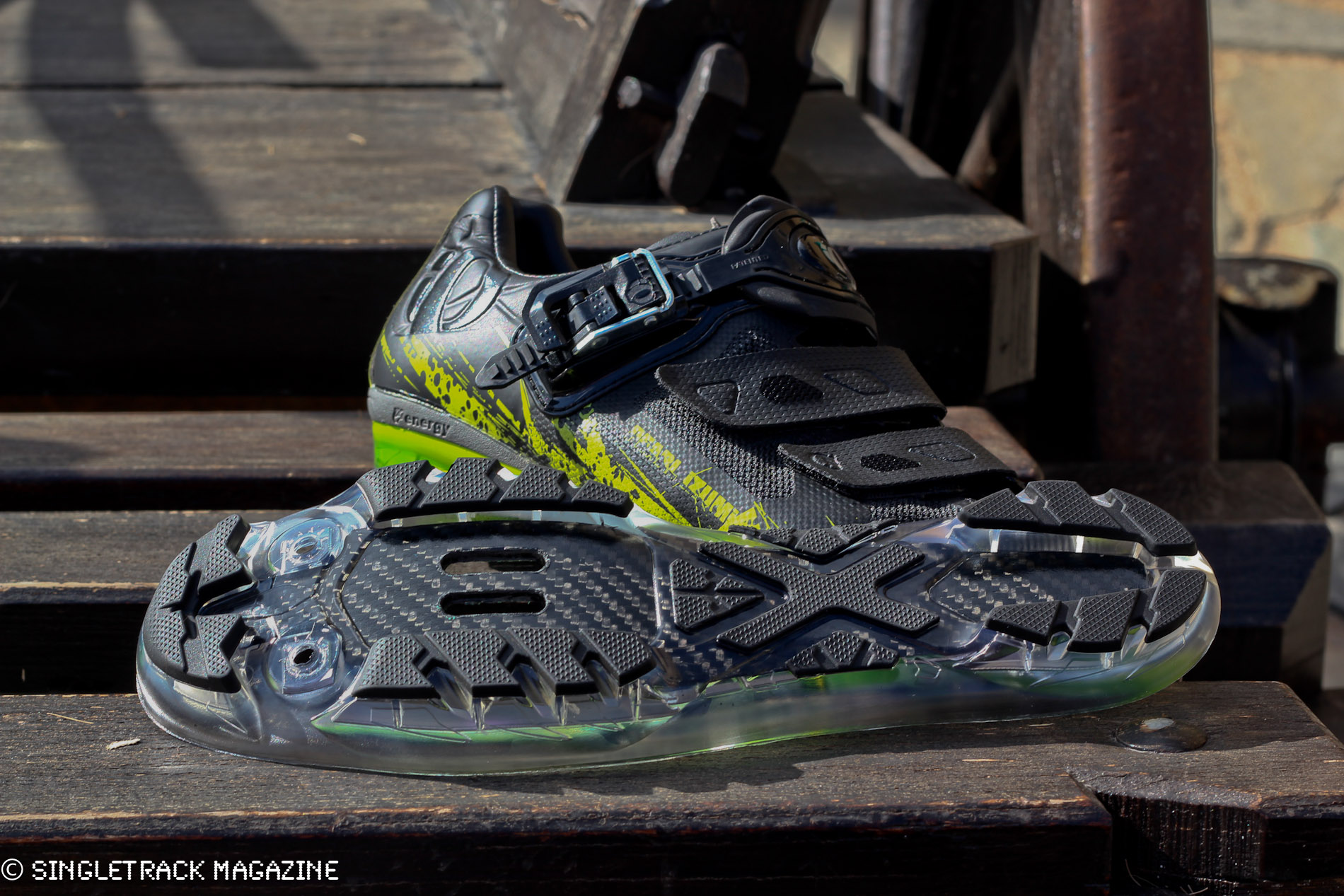Answering an invite to come to the Mediterranean island of Sardinia at the start of autumn is a bit of no brainer. Sun, sea, sand – all highly attractive things when summer has basically been one long and drawn out exercise in avoiding trenchfoot. While that’s all well and good for the lucky journos invited along, it does beggar the question – why all this for a shoe?
It’s quite simple really. Pearl Izumi reckon they’ve solved the great question of clipless mountain bike shoes; how to marry something with high pedalling efficiency but still make them comfortable for the inevitable hike-a-bike walking. If you’ve ever watched racers bambi-leg about then it’s obvious to see the downside of the traditional race shoe and their incredibly stiff soles; very good at transferring power from foot to pedal, kind of useless if you need to walk a longer distance than pit to race line, downright dangerous if you need to scramble up a muddy or rocky hillside.

The new range of X-Project shoes use a carbon fibre shank bonded into a hollow plastic sole, but the carbon fibre is deliberately more flexible at the toe and the heel to enable a more normal range of walking movement. The lightweight sole then has non replacable rubber lugs co-moulded to it to provide the grip needed off the bike. While making the sole more flexible may lead you to think that this design is less efficient at transferring power on the bike, the three months of testing Pearl Izumi carried out are said to prove otherwise.
http://www.youtube.com/watch?v=XGH1pw6W4MY
Working with one of the top US physiology departments to test the mantra that stiffer is better, volunteers rode on shoes that had layers of carbon removed from certain areas while riding at just below their lactic threshold, meaning they’d be unable to compensate for any deficiency in the shoes. Turns out that the tight’n’stiff “power through pain” crowd are misguided; making a shoe more flexible in the toe and heel doesn’t make any difference the amount of power you can put down. Less is more – or at least the same.

The heel also uses a bit of technology from their crossover X-Alp trail shoes, with an EVA ‘Energy Cell’ in the heel to absorb the shocks from, for example, rapid cyclocross dismounts and the like. That’s the general idea of these shoes, as test rider and generally speedy type Brian Lopes puts it: “Even if you’re not hiking that much, why not have a more comfortable shoe? It’s a no brainer”
After two years of testing prototypes with his input, Pearl Izumi are now happy with the finished item. Product manager Tony Torrance has a background in destructive engineering at General Motors, so with that knowledge and experience behind him, you’d hope they’d be made to last. Interestingly enough, he says one of the hardest parts was getting the grippy rubber lugs to stay put on the plastic sole, something they had to move production to Italy to get right – though the rest of the shoe is still made in the Far East.
All the models use a ratchet fastener on the instep with trimmable velcro straps, the top model using a neat instep pad that can be adjusted at either side to ensure correct, central positioning.
The shoe is certainly a tech fest – but have they done what they set out to achieve? In a word, yes. I rode the top end, super light X-Project 1.0 models on the rocky and dusty Sardinian trails and were highly impressed. Slip them on and they feel just about perfect for a racey shoe – plenty of room in the toe box but they can be snugged up nicely everywhere else. Sizing was decent, if slightly on the small side, but half sizes will be available. The top two shoes will also come with the very neat Pearl Izumi PRO 1:1 insoles, which come with a full set of inserts to adjust arch support and varus cant, ideal for the wonky legged.
Power transfer seemed to be on a par with pretty much every racey shoe I’ve ridden but the remarkable thing is the lack of foot pain I suffered, something I seem to find when using very stiff shoes. Although we sadly missed out on any hour long hike-a-bikes, crouching down to repair a bike or simply walking up an incline didn’t make me feel like I’d had my feet bound like a high status Chinese lady. After a while I simply failed to notice I was wearing any shoes, never mind racey clips.
I’m looking forward to testing them over the coming months – they could be the answer to my previous dislike of stiff shoes and if you’re thinking of taking on a ‘cross season, they’ll be just the ticket.
The top end X-Project 1.0 (£229.99) models use a cunning thermoplastic urethane coating over a mesh upper, meaning they’re very lightweight and very well vented, though those more used to Scottish rain than Sardinian sun will be relieved to know that the X Project 2.0 (£169.99) shoe uses a perforated synthetic leather cover instead, which should be a little cosier. The entry X-Project 3.0 (£129.99) model reverts back to the coated mesh but uses a bit more fibreglass in the sole, meaning they’re more affordable but slightly heavier. They also do without the adjustable insole – though that can be bought aftermarket for £34.99. The 2.0 and 3.0 are also available in women’s specific lasts, with sizes starting at 36 and going up to 43.

Comments (5)
Leave Reply
Post Comment













Damn. Just bought a pair of Sidi Dominator 5…
Maybe I’m a bit hard-of-thinking today, but these don’t appear to offer anything over and above the Shimano race-oriented shoes I’ve been using for the past couple of years. Apart from natty coloured soles, that is.
Also, they’re offering virtually zero ankle support, something you really need if you’re walking in the middle of nowhere…
@DoctorRad – Why, don’t your ankles support you in every day life? – Fell runners seem to manage in very low topped running shoes – Lots of backpackers in big mountains don’t wear boots either , why do mountain bikers need to?
I’m liking the look of these. I’ve been using Spesh Pro shoes for a few years now which are great for the majority of riding I do, except where hike-a-bike is required. Which is guaranteed on natural Scottish trails. Far too stiff and uncomfortable. Look forward to checking these out when they hit they shelves. Any release date?